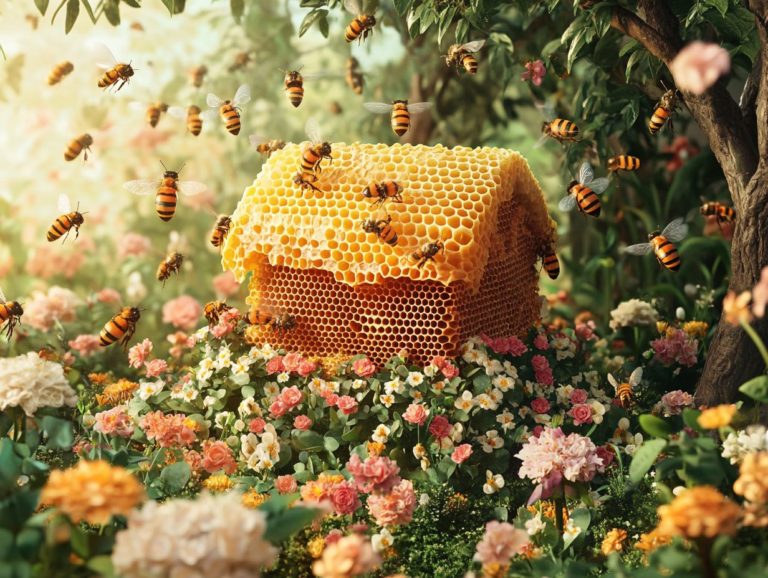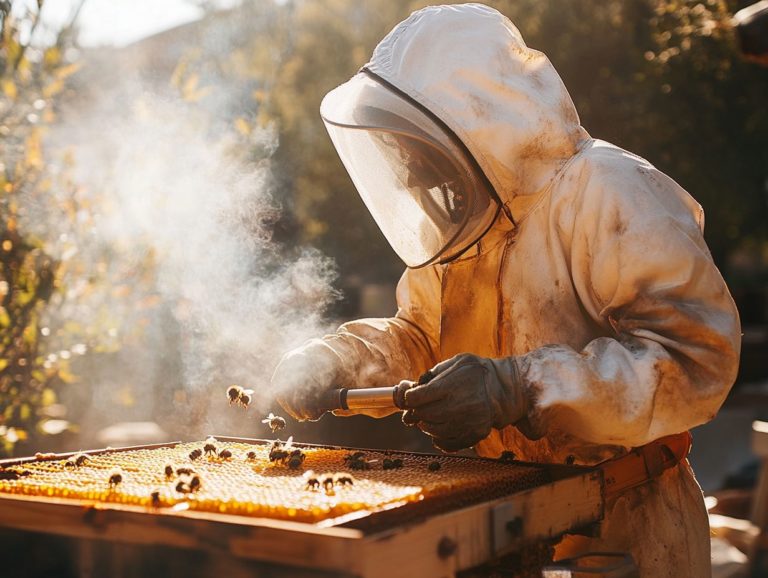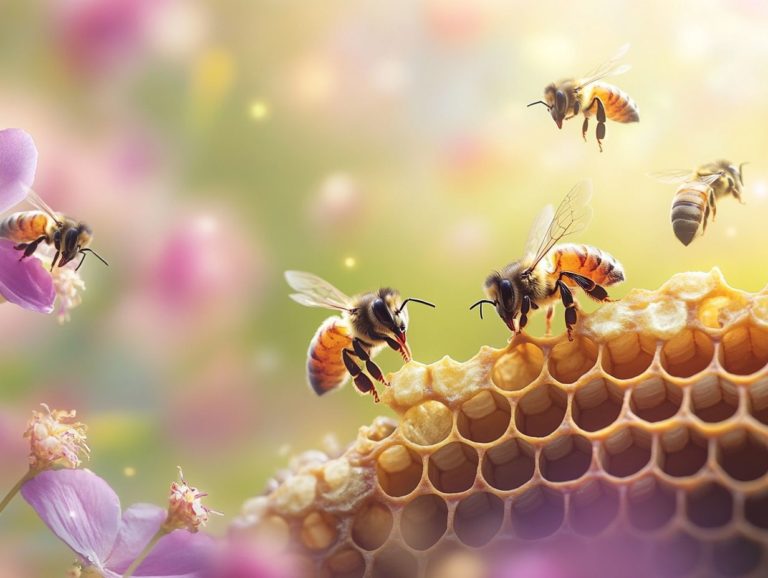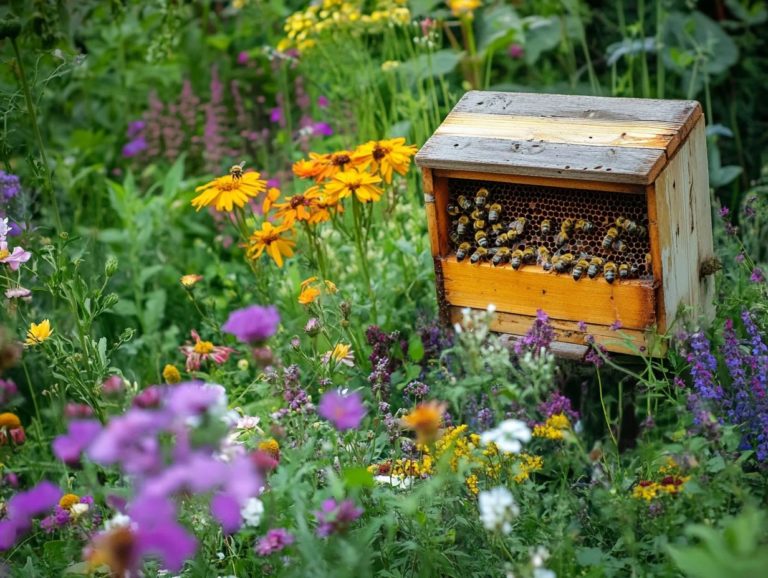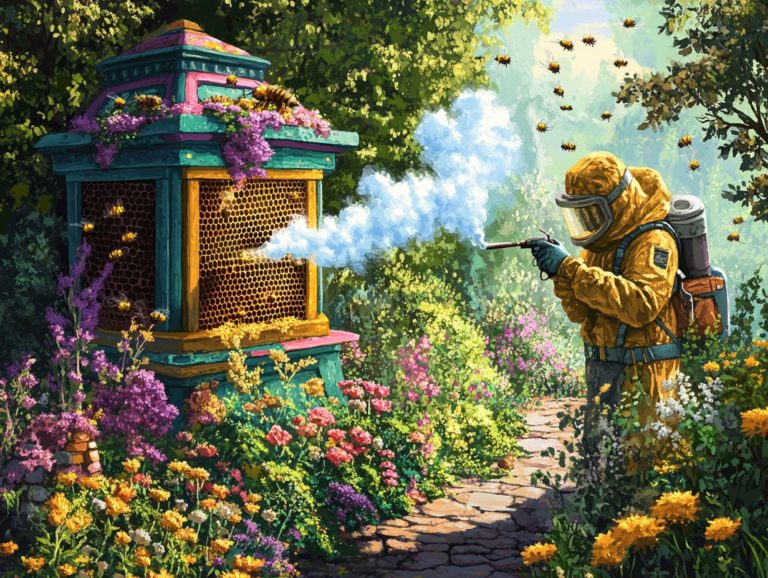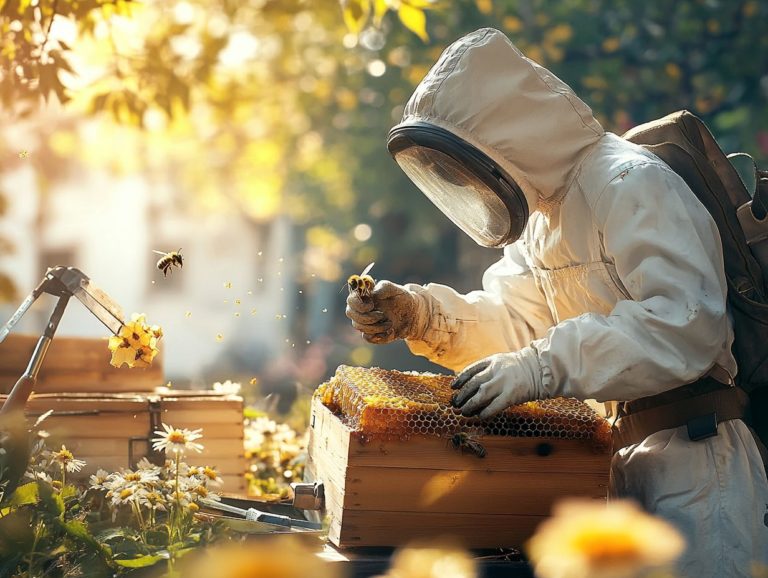Managing Hive Expectations
As you embark on your journey as a new beekeeper, you ll find that it can be as sweet as honey or as daunting as a swarm on a hot day. Understanding what to expect from your honey bee hive is essential for both your success and enjoyment.
This guide delves into the fundamental aspects of beekeeping, from the time it takes for a hive to establish itself to the realistic amount of honey you can expect to harvest, especially during the fall nectar flow.
You ll also discover the joy of beekeeping with practical tips that make your journey exciting and fulfilling!
By managing your expectations effectively, you can cultivate a thriving hive and enjoy a truly rewarding experience.
Contents
- Key Takeaways:
- The Importance of Managing Hive Expectations
- What to Expect as a New Beekeeper
- How to Set Realistic Goals for Your Hive
- Dealing with Unexpected Challenges in Colony Management
- How to Keep Your Expectations in Check
- The Rewards of Properly Managing Hive Expectations
- Frequently Asked Questions
- What is the importance of managing hive expectations?
- How can I effectively manage hive expectations?
- What are some common misconceptions about beekeeping?
- How can I manage my own expectations as a new beekeeper?
- What are some key factors to consider when managing hive expectations?
- What should I do if my hive does not meet my expectations?
Key Takeaways:
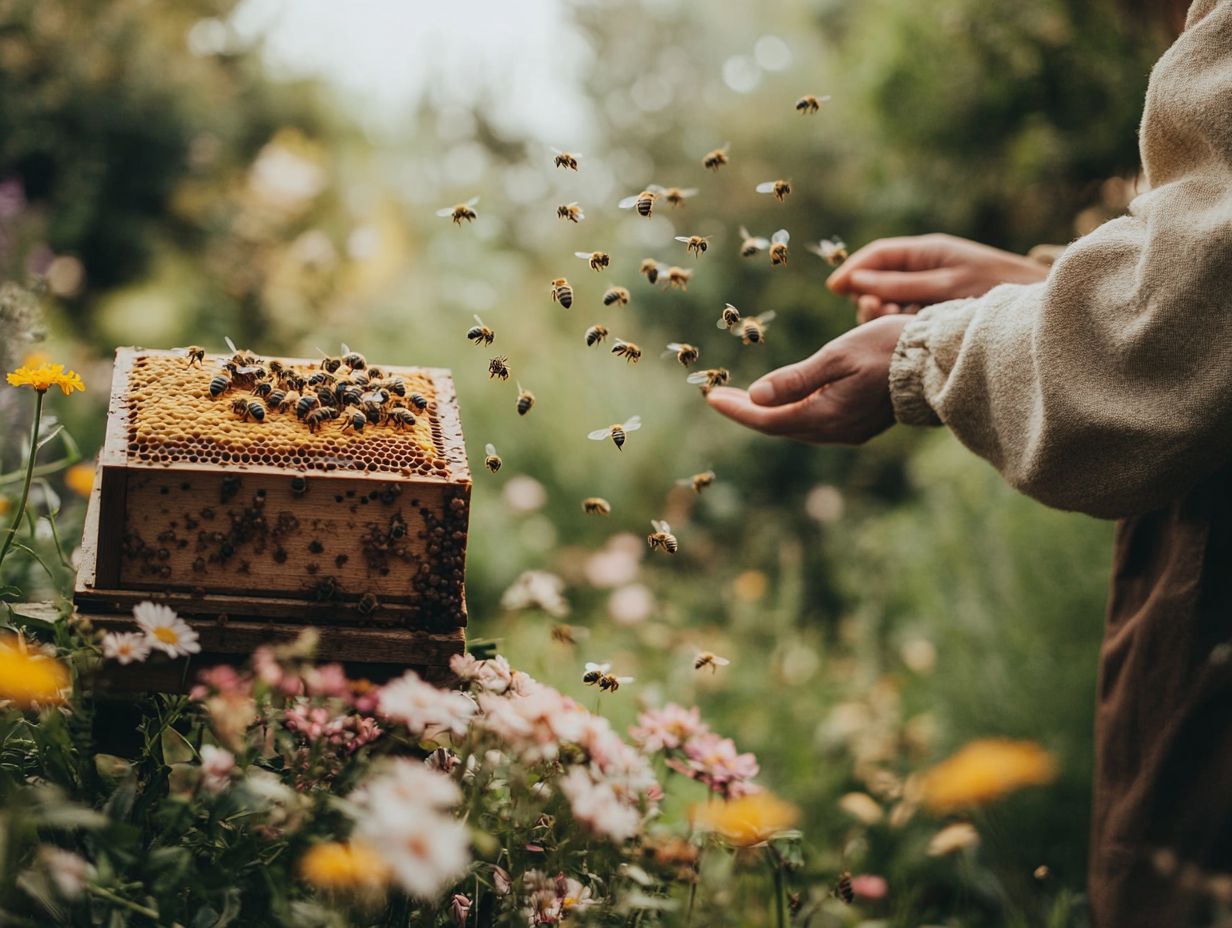
- Set realistic goals for your hive by assessing your resources and understanding the factors that affect hive productivity.
- Seek advice from experienced beekeepers and be patient and adaptable when facing unexpected challenges.
- Properly managing hive expectations can lead to healthy and productive hives, personal satisfaction, and contribute to the preservation of bees and the environment.
The Importance of Managing Hive Expectations
Managing hive expectations is essential for you, whether you’re a newcomer or a seasoned beekeeper, as it has a direct impact on the success of your honey production and the overall health of your colonies.
Gaining a deep understanding of the complexities of colony life is crucial for effectively managing your hives year-round. This includes understanding their seasonal behaviors and staying attuned to environmental conditions that influence the availability of nectar and pollen resources for your honey bees.
Conducting thorough hive inspections will help you identify potential problems such as varroa mites, which are pests that harm bees, and brood diseases. This allows you to implement more effective disease management strategies.
What to Expect as a New Beekeeper
As a new beekeeper, grasping the fundamental aspects of hive management is crucial for nurturing a thriving colony. You should take the time to familiarize yourself with the distinct roles of the queen honey bee, worker bees, and nurse bees, especially when it comes to brood rearing and maintaining the various components of the hive.
Moreover, keeping meticulous beekeeping records will enable you to monitor the colony s population effectively. This foundational knowledge will help you make informed decisions about extra feeding during times of nectar scarcity.
This knowledge will serve as the cornerstone for your long-term success in beekeeping, especially during periods of nectar dearth and ensuring winter survival.
How Long Does it Take for a Hive to Establish?
Establishing a honey bee hive can vary quite a bit based on several factors, including the management techniques you choose and the seasonal behavior of your bees. Typically, it takes a hive several weeks to really get settled in. During this time, the queen starts laying eggs while the worker bees focus on building brood and gathering resources.
Key elements, such as how often you inspect the hive and the health of your queen, are critical in determining how quickly your hive becomes fully functional. The timeline for hive establishment is influenced not only by the queen’s egg-laying prowess but also by the readiness and overall health of your worker bees.
Regular hive inspections are essential. They allow you to monitor the queen’s activity and assess the health of the colony. By addressing potential swarming behavior and disease issues like varroa mites early on, you can significantly speed up the hive s establishment. This ensures that your colony thrives and contributes effectively to pollination and honey production.
How Much Honey Can You Expect from a New Hive?
The amount of honey you can expect from a new hive hinges on several factors, including environmental conditions and the availability of floral resources during nectar flows. Generally, you might find that a new hive produces a modest honey harvest in its first year, particularly if the fall flow doesn’t support robust honey production.
By implementing effective management practices and ensuring there’s ample forage, you can significantly enhance your chances of a successful yield, especially by adding honey supers during peak nectar flows.
Various environmental factors play pivotal roles in honey production, such as temperature, humidity, and overall weather patterns. In ideal conditions, foraging and hive activity thrive, while adverse weather can impede the bees’ ability to gather nectar.
The availability of flowering plants directly influences both the quality and quantity of nectar that your bees can collect. Seasonal nectar flows, which vary by region, will greatly affect your honey production capabilities.
To optimize your honey harvest, it’s essential to monitor these factors closely and consider integrating practices such as:
- Planting diverse forage crops
- Ensuring the health of your hives
- Timing your honey extraction to align with peak production periods
What are the Basic Responsibilities of a Beekeeper?
Your responsibilities as a beekeeper include important tasks to keep your honey bee colony healthy and productive. Key duties include conducting regular hive inspections to monitor the queen’s health and managing brood rearing.
You must maintain the necessary components of the hive and use effective methods to manage diseases like varroa mites a common pest and brood diseases such as Chalkbrood, which is a type of brood disease.
Additionally, you’ll need to make decisions about supplemental feeding when nectar resources are low. Your role is essential for maintaining the hive’s sustainability. This means paying close attention to environmental factors that can influence bee behavior and productivity.
You’ll want to ensure adequate ventilation and prevent moisture buildup in the hive, as these conditions can promote harmful pathogens. Check the availability of pollen and nectar regularly to guide your management decisions. This enables you to make informed choices about hive placement and resource allocation, such as providing pollen substitute when necessary.
Nurturing a healthy queen through effective rearing techniques is also crucial, as she is central to the colony s reproduction and stability. All these responsibilities work together to create a thriving ecosystem that benefits not just your bees, but also the broader agricultural landscape.
This includes monitoring for queen cells and ensuring effective queen rearing practices. Don t wait monitor these conditions closely to boost your honey yield!
How to Set Realistic Goals for Your Hive
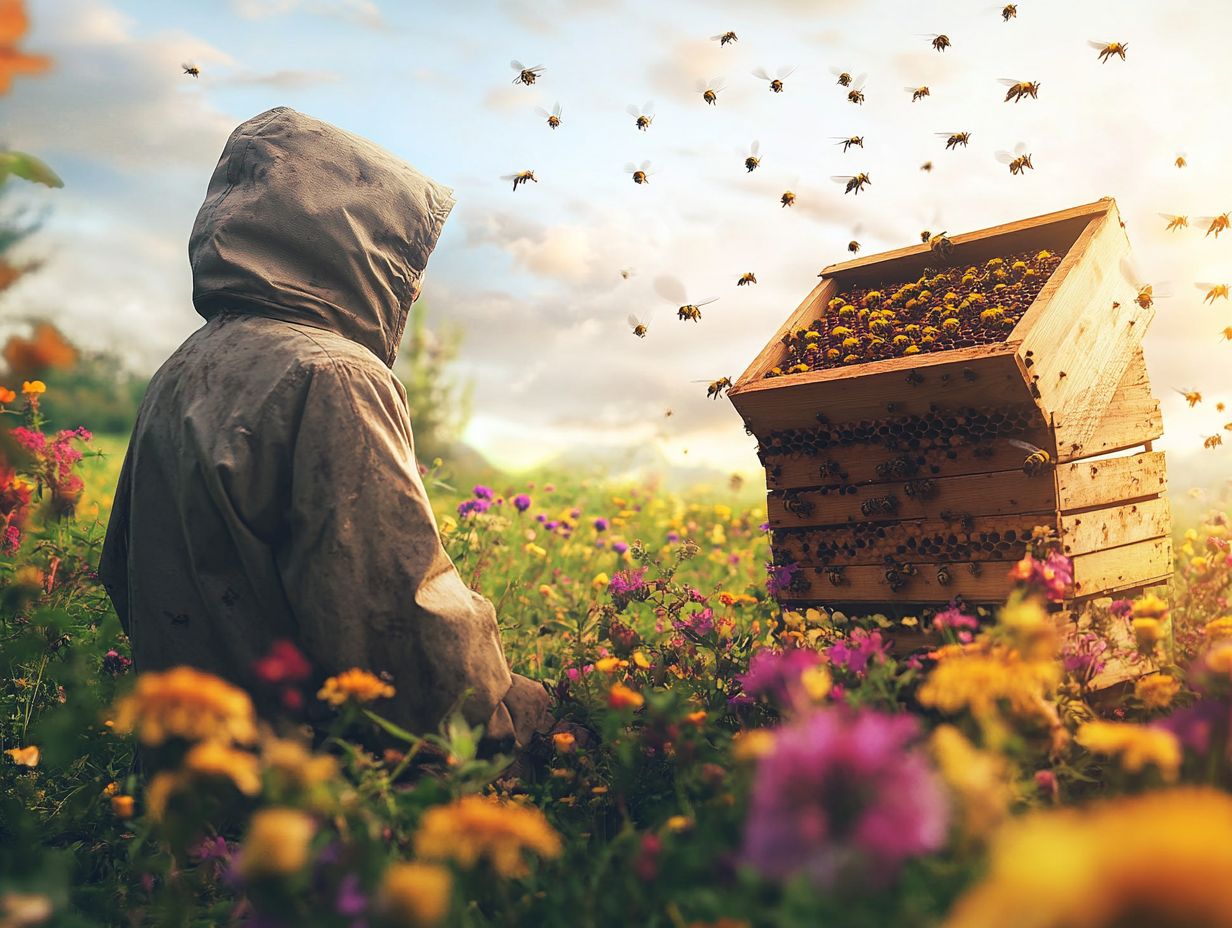
Setting realistic goals for your hive is a crucial step in mastering effective colony management and maximizing honey production. By grasping the environmental conditions and seasonal behaviors of honey bees, you can establish achievable expectations for your hive’s performance, including strategies for overwintering bees and ensuring their winter survival.
Your beekeeping practices, encompassing regular hive maintenance and diligent monitoring of colony health, will significantly influence the results of your goals, enabling you to adjust your approach as necessary.
Assessing Your Resources and Time Commitment
To thrive in this rewarding journey of beekeeping, it’s crucial to evaluate your resources and time commitment. Understanding the various aspects of your apiary management, including the availability of hive components and the time you can dedicate to regular maintenance, will greatly inform your decision-making process.
By evaluating the colony population and its specific needs, you can allocate your resources more effectively. Investing time in monitoring hive conditions such as moisture levels and food supply can help you prevent potential issues that may arise from negligence. This proactive strategy ensures that your bees receive the necessary support throughout their lifecycle, from the bustling spring build-up to the careful preparations for winter.
As you become more attuned to the behavior and characteristics of your colony, you’ll find it easier to identify when additional resources, like supplemental feeding or pest management supplies, are called for. Ultimately, a thoughtfully planned allocation of resources not only boosts hive productivity but also cultivates a healthier, more resilient bee population.
Understanding the Factors that Affect Hive Productivity
To maximize your honey harvest and keep your bees buzzing happily, understanding the factors that influence hive productivity is vital. Variables such as environmental conditions, seasonal behavior, and the availability of forage for nectar significantly affect how effectively your hive operates.
Regular hive inspections are critical; they allow you to identify any issues that could impede productivity, such as the presence of laying workers or the need for combining different methods to control pests. Recognizing the interplay between temperature, humidity, and seasonal changes is essential for fostering a healthy hive.
For instance, during warmer months, you ll notice the bees are more active, leading to increased foraging for nectar. Conversely, cooler weather can inhibit their efforts. The variety and abundance of nearby flowering plants directly impact the quantity and quality of nectar available, which ultimately influences your honey production capabilities.
By conducting frequent hive inspections, you not only keep an eye out for diseases or pests. You also make necessary adjustments in your management practices. This proactive approach enhances overall colony health, ensuring optimal conditions for honey production.
Dealing with Unexpected Challenges in Colony Management
Navigating unexpected challenges is an intrinsic aspect of beekeeping that demands your adaptability and proactive management strategies. Pests and diseases, like varroa mites and Chalkbrood, sacbrood, and brood diseases pose significant threats to colony health and colony management and can impede honey production.
Shifting environmental conditions add another layer of complexity. You need to stay vigilant and be prepared to tackle any emerging issues that may arise.
Weather and Environmental Factors
Weather and environmental conditions wield considerable influence over the productivity and health of honey bee colonies. As seasons change, these factors affect nectar flows and pollen resources. Variations in these conditions can affect nectar flows, pollen resources, and the overall behavior of bees throughout the year, significantly impacting honey production. To manage your hives effectively, it s essential to remain informed about these environmental shifts.
For example, when prolonged periods of drought occur, you might notice a decrease in flowering plants, leading to reduced forage availability for your bees. This can compromise their wellness and honey yields. Likewise, unseasonably cool or wet weather can disrupt foraging activities, making your bees less inclined to venture outside.
To tackle these challenges head-on, consider implementing strategies such as:
- Planting a diverse array of spring flowers of pollen and nectar-rich plants nearby to boost forage availability.
- Supplementing your colonies with sugar syrup or protein patties during lean periods.
- Adjusting the placement of your hives to areas with different weather conditions that provide sheltered conditions and better resource access.
By adopting these strategies, you can dramatically improve your colonies’ productivity and ensure they thrive through any challenge. Don t wait! Start implementing these tips today for a bountiful honey harvest this season!
Pests and Brood Diseases
Pests and diseases pose substantial threats to your honey bee colonies. Effective disease management and combined pest control methods are crucial for your success in beekeeping. Varroa mites and various brood diseases can swiftly decimate a colony if you don t address them through regular hive inspections and proactive measures. Identify these threats early to protect your bees and boost your honey production!
Beyond the infamous varroa mites that latch onto bees and siphon their lifeblood, be aware of other concerns like foulbrood and nosema. These issues can stunt the growth and health of bee larvae. A comprehensive disease management strategy involves recognizing these problems and routinely monitoring optimal hive conditions. This includes proper comb rotation and managing queen cells.
Diligent hive inspections allow you to catch symptoms early, assess the effectiveness of your treatment methods, and safeguard your colonies from population declines. Such proactive approaches are essential for nurturing healthy bee populations, which are vital for pollinating crops and maintaining colony life.
How to Keep Your Expectations in Check
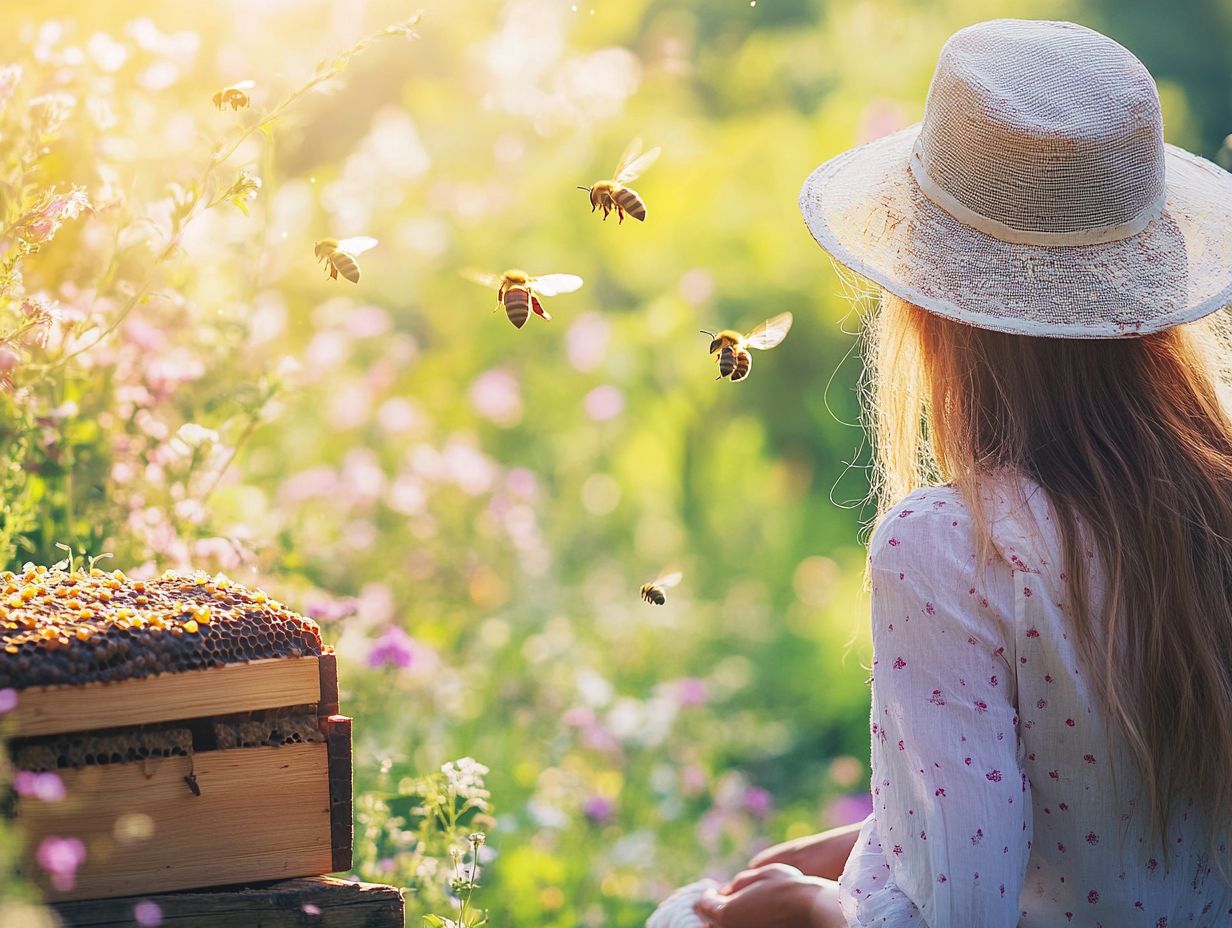
Maintaining a realistic outlook is essential for nurturing a healthy perspective on your beekeeping journey. Many factors influence honey production. Expecting immediate success may lead to disappointment.
By embracing patience and adaptability in your beekeeping practices, you ll be better equipped to navigate the challenges and uncertainties that accompany the delicate art of hive management.
Seeking Advice from Experienced Beekeepers
Seeking advice from experienced beekeepers can elevate your understanding of effective hive management and enhance your overall practices. Mentorship in this field offers invaluable insights into the intricacies of honey production and colony health. This helps you to make informed decisions and sidestep common pitfalls.
Connecting with seasoned practitioners allows you to adopt best practices that lead to healthier bees and increased yields. These relationships create a supportive network where sharing experiences, challenges, and successes becomes natural.
Experienced beekeepers often highlight the importance of making seasonal adjustments in hive maintenance, the critical nature of pest management, and the benefits of selecting the right apiary location for optimized honey production. This collaboration nurtures a deeper appreciation for the art of beekeeping and fosters a culture of continuous learning, leading to thriving colonies and improved outcomes.
Being Patient and Adaptable
Being patient and adaptable is essential for cultivating a successful beekeeper mindset. Honey production and hive management often require both time and flexibility. Seasonal behaviors can significantly impact your colony’s growth and honey yield, making it crucial to adjust your practices as circumstances evolve.
Understanding the natural rhythms of bee activity is key. For instance, fluctuations in floral availability dictate when your bees forage most effectively. You must be attuned not only to your colonies but also to the surrounding environment.
When unexpected weather changes arise or pests infiltrate your hives, having the patience to allow your bees to recover and the adaptability to implement new strategies, including the use of oxalic acid or other treatments, becomes vital. By nurturing these qualities, you can enhance your honey production and foster a more balanced ecosystem within your apiaries. This leads to a thriving practice that yields consistent results.
Celebrating Small Victories in Beekeeping Practices
Celebrating small victories in beekeeping practices can significantly amplify your motivation and commitment, nurturing a positive beekeeper mindset. Whether it s your first successful honey harvest or mastering hive maintenance, recognizing these milestones bolsters your confidence and fuels your dedication to the health of your colonies.
When you take the time to acknowledge these achievements, no matter how small they might appear, you create a ripple effect of positivity and enthusiasm throughout your beekeeping journey. It’s those little wins like spotting the queen or observing healthy brood patterns that remind you of the progress you’re making. Each minor achievement provides a sense of accomplishment, reinforcing your commitment to learning and refining your skills.
This practice doesn t just build resilience; it also fosters a supportive community among fellow beekeepers, allowing you to share in moments of joy and inspiration. Celebrating your small victories leads to greater success in your beekeeping endeavors.
The Rewards of Properly Managing Hive Expectations
Effectively managing hive expectations can yield a wealth of rewards for you as a beekeeper. You’ll enjoy not only healthy and productive hives but also a profound sense of personal satisfaction, all while making a significant contribution to the preservation of bees.
Aligning your goals with realistic expectations boosts your chances for successful honey production and overall beekeeping triumph. This alignment cultivates a fulfilling relationship with your colonies, enriching your beekeeping experience.
Healthy and Productive Hives with Proper Hive Components
Keeping your hives healthy and productive can be one of the most thrilling parts of beekeeping! A thriving colony not only boosts your honey production but also enhances the overall health of the local ecosystem, underscoring the vital importance of successful beekeeping practices.
The hallmark of a robust hive includes a well-organized social structure, ample food reserves including honey stores, and a strong resistance to diseases. By carefully monitoring bee population trends and environmental factors, you can create optimal conditions that nurture these essential traits, allowing your colonies to truly flourish.
With a vigorous workforce, including nurse bees and worker bees, your bees will be better equipped to forage efficiently, which translates into increased nectar collection and, ultimately, higher honey yields. Effective hive management also fosters genetic diversity within your colony, further strengthening its resilience against pests and diseases, ensuring ongoing productivity and sustainability.
The synergy between your attentive care and the bees’ natural behaviors plays a crucial role in achieving your beekeeping success, ultimately resulting in a rewarding honey harvest.
Personal Satisfaction and Fulfillment in Beekeeping
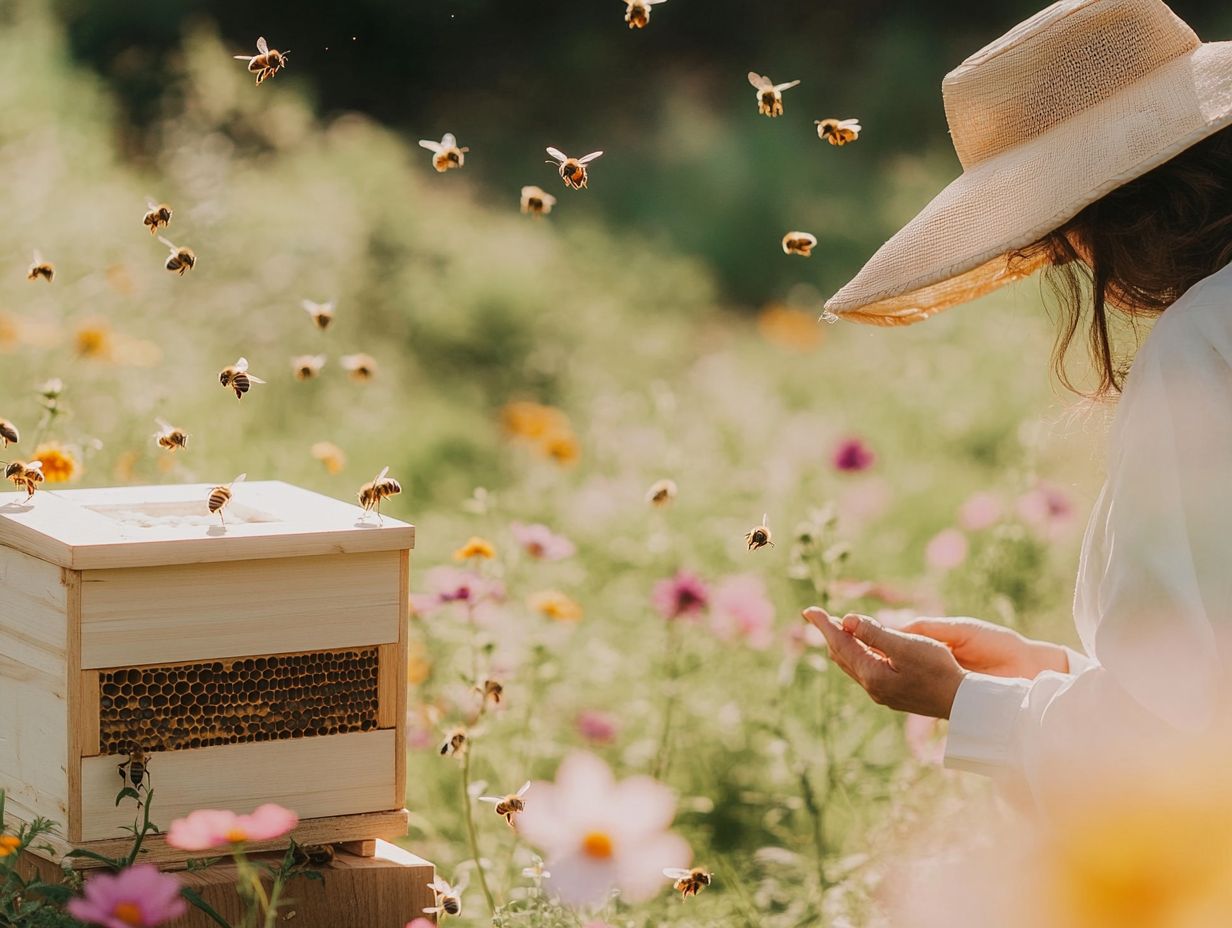
Your personal satisfaction and fulfillment in beekeeping arise from the sheer joy of watching a colony flourish and produce honey. By skillfully managing hive expectations and nurturing colony health, you can experience a profound sense of accomplishment that enriches your entire beekeeping journey.
The intricate dance of bees tirelessly gathering nectar is not only a captivating sight but also a powerful reminder of the resilience and beauty of nature. This connection to a thriving ecosystem resonates deeply within you, offering emotional rewards that transcend the tangible product of honey.
As you witness the fruits of your labor manifest through the growth of a robust hive, you often cultivate a lasting appreciation for sustainability and ecological balance. The profound relationships you form with these remarkable insects can inspire a genuine sense of purpose, contributing significantly to your overall well-being and fulfillment in life.
Contributing to the Preservation of Bees and the Environment
Contributing to the preservation of bees and the environment stands as one of the most rewarding pursuits for dedicated beekeepers like yourself. By embracing sustainable practices that keep bee colonies healthy and increase honey production, you play a critical role in upholding ecological balance and ensuring the survival of these vital pollinators.
These sustainable techniques enhance bee populations and foster biodiversity, a cornerstone of healthy ecosystems. Employing practices such as rotating hives to curb the spread of disease and utilizing organic methods for pest control can create a welcoming habitat for bees. Planting a variety of flora around your hives places where beehives are kept also supports their well-being.
As a beekeeper, you act as an environmental steward, raising awareness about the challenges that bees face, such as habitat loss and climate change. Your role in educating the public is vital for inspiring action toward environmental preservation and securing the future of pollinator health. Act now to help save bees and preserve our environment. Every small step counts!
Frequently Asked Questions
Let s clear up some common questions about beekeeping!
What is the importance of managing hive expectations?
Managing hive expectations is crucial for maintaining a healthy and productive hive. It helps prevent disappointment and frustration for beekeepers while ensuring the well-being of the hive.
How can I effectively manage hive expectations?
Effective management of hive expectations involves setting realistic goals and understanding the natural behaviors of bees. It also requires proper education and preparation before starting your beekeeping journey.
What are some common misconceptions about beekeeping?
One common misconception is that beekeeping is easy and requires minimal effort. In reality, it demands significant knowledge, time, and dedication to properly care for a hive.
Another misconception is that beekeeping is a quick way to make money when, in fact, it can take years to establish a profitable hive.
How can I manage my own expectations as a new beekeeper?
As a new beekeeper, it s important to have realistic expectations and not compare yourself to experienced beekeepers. Start with smaller goals and gradually work your way up as you gain more knowledge and experience.
What are some key factors to consider when managing hive expectations?
Key factors to consider include weather conditions, food availability, and the overall health of the hive. These factors can greatly impact the productivity and success of a hive.
What should I do if my hive does not meet my expectations?
If your hive does not meet your expectations, assess the situation and identify potential issues. Seek advice from experienced beekeepers and continue to educate yourself on proper hive management. Remember that every hive is unique, and it takes time and patience to see the desired results.

